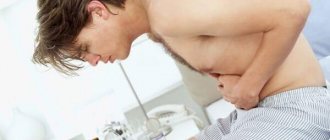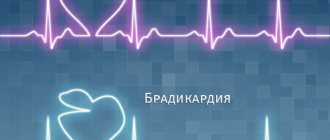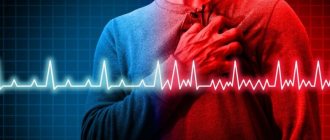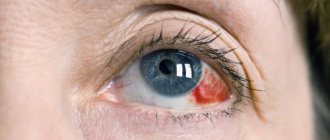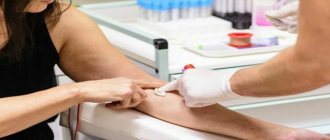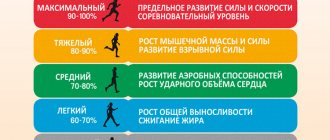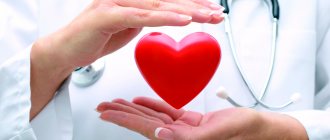Symptoms and nature of pain
If you have chest pain, you need to pay attention to its nature, location, duration.
Depending on the developing disease in the chest area, the signs will be individual. Usually the pain is accompanied by cough, vomiting, abdominal pain and other symptoms. In order to more accurately make a diagnosis and determine the cause of its occurrence, it is important to know what the nature of the pain syndrome may be.
- Drawing and burning. A person can feel such discomfort behind the sternum after physical activity and at rest. The painful sensation can last from 10 to 60 minutes in any body position.
- Increased or decreased pain. Associated with a person’s unhealthy lifestyle. Typically occurs during jogging, climbing stairs, and carrying heavy objects.
- Irradiating. Chest pain radiates under the shoulder blade, to the left or right arm. May gradually move towards the neck or jaw. There is no clear localization.
- Acute and paroxysmal. Often, this symptom appears with intercostal neuralgia, if there has been intense physical activity before.
- An intensifying syndrome occurs when trying to take a deep breath or raise your arms. It also appears after long walks or driving a car.
Spasmodic pain occurs less frequently if there is any interference in the body with the movement: tumor, growths, hematoma, fractures and other injuries.
Calcification of ligaments
Description Calcinosis is a process in which calcium is deposited in some places of the spine . Calcification of the ligaments is called calcification. This condition occurs for various reasons (for example, as a protective reaction of the body to damage), but the result is the same - the ligament or joint loses its mobility, as it partially turns into bone. Nature of pain Calcification, located in the dorsal or thoracic region, causes sharp, stabbing and severe pain, observed with a certain movement of the body.
This is due to the fact that the ligament that has lost its elasticity sharply puts pressure on the nerve when walking.
Additional symptoms Depend on the cause of calcification (tuberculosis, intervertebral hernia). Who diagnoses and how? Therapist. Methods: blood and urine tests, anamnesis. Treatment: Medication. Preparations containing magnesium return the calcium balance in the body to normal.
Article on the topic: Right side is painful and painful
Calcinosis is a concomitant disease.
Expert opinion Mitrukhanov Eduard Petrovich Neurologist, city clinic, Moscow. Education: Russian State Medical University, GBOU DPO Russian Medical Academy of Postgraduate Education Ministry of Health of the Russian Federation, Volgograd State Medical University, Volgograd. There is no point in treating only it - the cause must also be eliminated.
Causes related to the heart
There are plenty of influencing factors. However, first of all it is necessary to deal with the most dangerous ones. They can be fatal if treatment is not started in time. The reasons may be cardiac or non-cardiac.
Chest pain when running or walking indicates heart problems. A colossal load is created on the organ, as a result of which the patient feels unwell.
- Myocardial infarction. During a heart attack, oxygen supply to the heart is cut off as the coronary arteries close. Due to such a deficiency, the heart muscle can die. Associated symptoms include: shortness of breath, chest pressure, increased sweating, anxiety and nausea.
- Angina pectoris. Caused by insufficient blood flow to the organ. The patient feels pressure and tightness on the left side or under the shoulder blade. Associated symptoms are shortness of breath, discomfort in the arms and jaw, nausea, and dizziness.
- Cardiomyopathy (hypertrophic). Occurs when the cells of the heart muscle increase, and the walls of the ventricles are compressed, hence pain and other typical heart symptoms appear. Sometimes fainting is possible.
Pericarditis - Pericarditis. Occurs due to inflammation of the pericardial sac. May result from an infectious or autoimmune disease. An additional symptom is fever. Swelling of the neck and face occurs, and veins under the skin become visible.
- Mitral valve prolapse. Occurs if its valves bend inward and blood is thrown from the atrium into the ventricles. If the condition is serious enough, it is accompanied by pain.
Heart pain cannot be prevented. They may be related to heredity. When the first symptoms appear, you need to call an ambulance.
Intercostal neuralgia
Description Intercostal neuralgia is a condition in which the nerves located between the ribs are pinched by the same ribs . Intercostal neuralgia can be caused by tumors, inflammation, and trauma. Nature of pain Pain sensations occur sharply, with a certain rotation of the body while walking or other loads associated with constant movement. The patient is “shot” from the rib to the spine or arm. If you change position, the pain goes away over time until the next pinching occurs.
In addition, the pain changes with breathing: it intensifies when you inhale, weakens when you exhale.
Additional symptoms : Bruises and abrasions (from injuries), fever (from inflammation). Who diagnoses and how? Neurologist. Methods: medical history, general and biochemical blood tests, urine test for protein, MRI, CT, X-ray, ultrasound of the abdominal organs, ECG. The diagnosis is made by exclusion. Treatment Painkillers. The rest of the treatment depends on the cause of the pinched nerve.
Article on the topic: Detailed instructions for use of the drug Diclofenac Akriquin
Non-cardiac pathologies
Pleurisy of the lung
There are many conditions that cause chest pain when bending, squatting, walking up stairs or carrying bags. Pain occurs in people of all ages.
Respiratory problems
The lungs are the second important organ for human life. Associated pathologies need to be quickly identified. Possible diseases include:
- pleurisy, characterized by inflammation of the pleura;
- acute and chronic bronchitis, accompanied by a constant cough;
- pneumonia with regular blood in the sputum;
Inflammation of the bronchi - inflammation of the bronchi;
- laryngotracheitis;
- asthma.
Exposure to viral infections (acute respiratory infections, acute respiratory viral infections, influenza) is accompanied by hyperthermia, runny nose, and cough. Associated symptoms may appear individually.
The early stages of diseases of the respiratory system are often accompanied by minor pressing discomfort, most often the chest hurts in the middle when moving. If left untreated, symptoms worsen over time.
If the nature of the pain is constant and does not go away when changing positions, during rest and sleep, then an inflammatory process begins in the body.
Diseases of the gastrointestinal tract
Cause of heartburn
Inflammation of the esophagus, walls of the stomach or intestines often manifests itself as radiating pain. It radiates to the middle part of the sternum and to the lower back. Among the gastrointestinal diseases that appear during movement are:
- Heartburn with the release of stomach acid into the esophagus. The syndrome persists for a long time. Does not disappear without the use of appropriate pain medications.
- Stagnation of food is accompanied by pressure on the walls of the esophagus, which causes pain. It intensifies during breathing, bending, raising arms and fast walking.
- Acute liver disease or infection of the organ with parasites. Cell destruction is accompanied by heaviness on the right side of the chest. The pain may radiate to the middle of the chest or right arm.
- Gallbladder disease. Accompanied by acute pain syndrome. Refers to the chest. You may suspect problems with the lungs.
Diseases of the musculoskeletal system
In case of joint problems, chest discomfort is considered common. The development of such pathologies is associated with this:
- scoliosis;
- intervertebral hernia;
- calcification of ligaments;
- instability of the thoracic spine (displacement);
- myofascial syndrome – provokes damage to the ligaments, after which pain appears during physical activity.
At first, diseases of bones and joints do not show any symptoms. Pain occurs at stages 2-3 of pathology development.
Intercostal neuralgia
It is usually considered a consequence of problems with the musculoskeletal system, but is more often caused by reduced resistance to stress and a tendency to panic attacks. Accompanied by pain in the left side of the chest. It can be sharp and long-lasting. In this state, it is difficult for a person to take a deep breath. May affect the lower back during exacerbation.
Traumatic consequences
Some time after receiving a chest injury, a dull or aching pain may appear at the site of injury. This sign indicates that inflammation has occurred or an internal hematoma has appeared. It is important to correctly understand where the pain is located.
Why does pain occur in the heart area when running?
Each person experienced fatigue, shortness of breath, or discomfort in the upper abdomen or behind the sternum during intense physical activity.
These symptoms force the athlete to stop training and are often accompanied by fear of a “heart attack.”
However, there are several causes of pain in the heart when running, which are associated with both increased blood supply to the organs and relative ischemia of the heart muscle. The appearance of symptoms should not be ignored, but not all of them require emergency medical attention.
Causes of discomfort
Cardialgia refers to pain in the heart area that occurs due to myocardial pathology or diseases of other structures of the chest cavity. The mechanism of this symptom is associated with the peculiarity of the influence of running on the human body.
Jogging or sprinting, cycling, swimming are cardio workouts. These sports are aimed at increasing the tidal volume of the lungs, which improves the saturation of organs and tissues with sufficient oxygen. In addition, during exercise, the heart rate increases and metabolic processes accelerate.
Pain in the heart area when running is caused by the following reasons:
- Insufficient physical training of the athlete . High intensity exercise is a serious stress for an untrained person. Performing exercises and increasing the load trigger the processes that are necessary for the adequate functioning of the body in such conditions. The accumulation of under-oxidized products, a sudden acceleration of blood flow and respiratory rate disrupt the adaptive capabilities of the human body.
- Cramps in the chest muscles . The intercostal muscles take part in the act of breathing with a deep or rapid rhythm. In addition, their involuntary contraction occurs during each fast step on the treadmill. Depletion of glycogen reserves and insufficient oxygen supply develop convulsions, which cause pain in the heart area. A distinctive feature of this symptom is a clear localization (you can point with your finger) or increased pain on the left when bending to the right side (due to stretching).
- Heartburn . Jogging increases intra-abdominal pressure, as a result of which the cardiac sphincter of the stomach (the muscle at the border of the organ with the esophagus) relaxes. In this case, its contents are thrown upward, and due to the interaction of hydrochloric acid with the mucous membrane of the esophagus, a burning pain occurs behind the sternum.
- Pathology of the lungs . Diseases of the respiratory system (bronchial asthma) cause heart pain during running due to inadequate oxygenation of the blood.
The most serious cause of discomfort in the chest when playing sports is angina pectoris. This diagnosis characterizes insufficient blood supply to the heart due to damage to the coronary vessels.
During training, the myocardium's need for oxygen and nutrients increases.
With vascular incompetence, ischemia and pain occur, which are accompanied by shortness of breath, nausea, vomiting, increased sweating and dizziness.
What to do if discomfort occurs
The appearance of pain during physical education is a signal to stop training. For a further successful career in sports and to prevent the recurrence of pain, it is recommended:
- consultation with a doctor to determine the underlying cause;
- reducing the intensity of exercise if pain occurs for the first time against the background of a sharp increase in load;
- do not eat 1-1.5 hours before training (exclude the possibility of reflux);
- a balanced diet containing sufficient amounts of proteins, fats and carbohydrates, vitamins and minerals;
- regulate rest periods, which are necessary for sufficient recovery of muscles and internal organs. An increase in endurance and strength occurs both as a result of intensive training and adequate relaxation to consolidate the achieved result.
People with chronic pathology, which causes pressing pain in the heart area, are recommended to consult with a doctor regarding the dosage of medications before playing sports or competitions.
Building the right training regime
Professional athletes often seek the help of a sports doctor, who draws up a training plan in accordance with the person’s clinical parameters and level of adaptation to stress. A rational approach to sports involves adherence to several principles:
- constancy - effectiveness is largely determined by the absence of long pauses between training, since each break implies the need to re-adapt organs and systems to stress;
- gradualism - a step-by-step increase in intensity adequately develops the habituation of both muscles and internal organs;
- accessibility – training regimes should be suitable for athletes with different levels of fitness;
- individuality - the training plan is drawn up taking into account the characteristics of the body of a particular person;
- variability - the ability to choose classes with different effectiveness or technique, which comprehensively develops physically.
Diagnostic methods
Stress ECG procedure
When contacting a therapist, the patient must know exactly when and under what circumstances the pain appeared. This will make it possible to quickly determine which organ is involved in the pathological process. The doctor can give a referral to a surgeon, pulmonologist, or otolaryngologist.
Typically, several stages of research are carried out.
- Palpation of the location of pain, determination of the condition of the skin and adjacent tissues. This also includes taking an anamnesis.
- ECG (electrocardiogram) stress type. This examination involves measuring heart function at rest and during exercise. In combination with it, blood pressure is recorded with a tonometer.
Sigmoidoscopy procedure - If pulmonary problems are suspected, an x-ray is required. If necessary, use a dye. It makes it possible to understand how widespread the inflammation is and which tissues are affected.
- Sigmoidoscopy, ultrasound of the internal organs of the gastrointestinal tract. The complex also performs endoscopy. It helps to reliably study the condition of the mucous membrane of the intestines and stomach.
If cancer is suspected, patients are prescribed an MRI and a needle biopsy.
If your chest hurts in the middle when bending over once a month, this may be a harbinger of menstruation.
Prevention and safety
It is necessary to adhere to a balanced diet
By adhering to important rules and recommendations, a person can avoid the appearance of pain in the chest area if they are not associated with cardiac problems.
- Eat a balanced diet and eliminate junk food from your daily diet.
- Play sports, any home gym will do. This will help prevent obesity and excess stress on the body.
- Give up bad habits: smoking, alcohol. Also, do not consume a lot of caffeine and stimulating drinks.
- Monitor your blood pressure and avoid hypertension and hypertension.
- Avoid physical activities that, without prior preparation, may result in chest injuries.
- With chronic asthma, it is necessary to control all attacks and have an inhaler on hand. Travel to hospitals and sanatoriums is allowed.
Any condition associated with chest pain during exercise and causing concern requires consultation with a specialist. Neglected pathology is sometimes dangerous to health and life.


